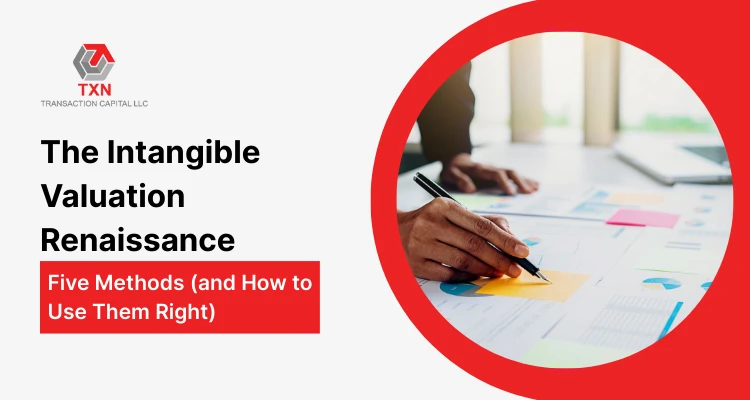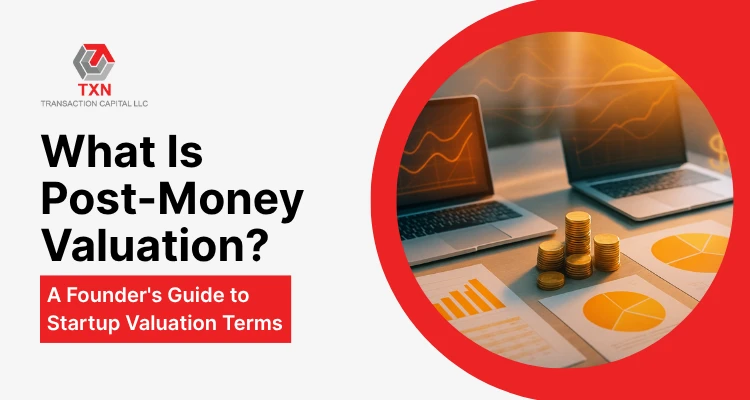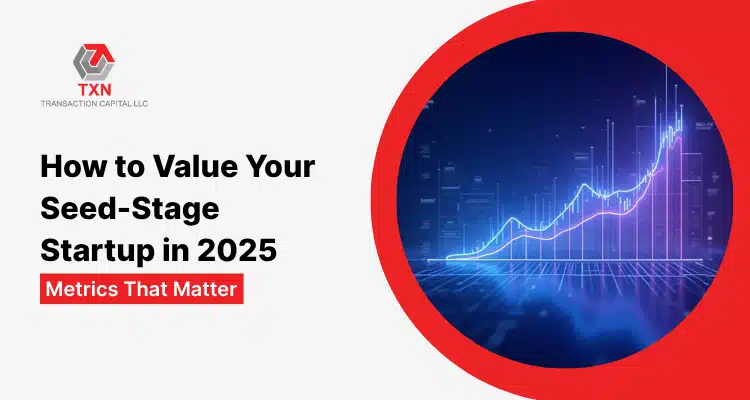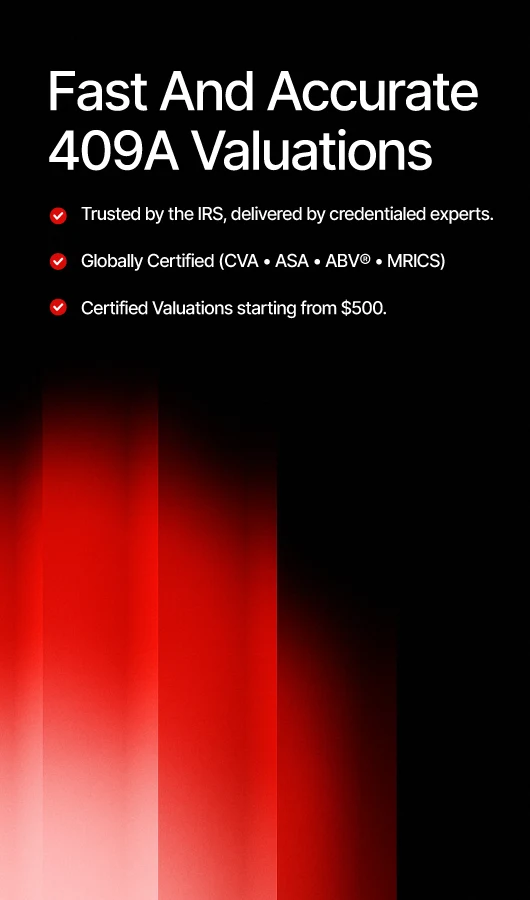The Intangible Valuation Renaissance: Five Methods (and How to Use Them Right)

What Makes the Intangible Valuation Renaissance Critical for Modern Businesses?
Valuing intangible assets is one of the most critical yet complex parts of business valuation. Unlike tangible assets, their worth is often subjective and difficult to measure. Business owners sometimes overestimate the value of brand strength, customer relationships, or proprietary knowledge.
But when it comes to raising capital, defending tax positions, passing audits, or selling a business, optimism alone won’t cut it—you need defensible valuation methods that withstand the scrutiny of investors, auditors, and regulators.
At Transaction Capital LLC, we deliver certified, audit-ready intangible asset valuations that transform hard-to-measure advantages—such as intellectual property, software, data, brand equity, and contracts—into a clear, defensible fair market value (FMV).
In this guide, we break down what qualifies as an intangible asset, why comparable can be unreliable, and how to apply five proven valuation methods with practical examples and compliance insights.
Why Do Intangible Assets Drive Today's Business Value?
Modern enterprises increasingly rely on non-physical assets that generate substantial economic returns. Unlike traditional manufacturing companies built around tangible machinery and inventory, today's successful businesses leverage intellectual property, technology platforms, and customer relationships as their primary value drivers.
Consider how software companies monetize proprietary algorithms, how pharmaceutical firms capitalize on patent portfolios, or how consumer brands command premium pricing through reputation and customer loyalty. These intangible advantages often represent 70-80% of total enterprise value.
The challenge? Standard accounting practices don't capture internally developed intangibles on balance sheets. This creates a massive gap between book value and market value, making professional intangible asset valuation essential for accurate business assessments.
What Qualifies as an Intangible Asset in Business Valuation?
The International Glossary of Business Valuation Terms defines intangible assets as non-physical resources that provide measurable economic benefits to their owners. These assets fall into several distinct categories:
1. Intellectual Property Rights:
- Patents protecting innovative technologies and processes
- Trademarks safeguarding brand identities and logos
- Copyrights covering creative works and content
- Trade secrets containing proprietary methodologies
2. Technology and Data Assets:
- Proprietary software applications and platforms
- Machine learning algorithms and AI models
- Customer databases and behavioral analytics
- Technical documentation and know-how
3. Commercial Relationships:
- Customer contracts and service agreements
- Distribution networks and channel partnerships
- Licensing agreements and royalty streams
- Non-compete clauses and exclusivity arrangements
4. Brand and Market Position:
- Company reputation and brand recognition
- Domain names and digital presence
- Social media followings and online communities
- Market positioning and competitive advantages
These assets generate value through product margins, licensing revenues, network effects, or premium pricing that wouldn't exist without the intangible advantage.
How Do Intangible Assets Differ from Tangible Business Assets?
The distinction between tangible and intangible assets goes beyond physical presence. Understanding these differences shapes valuation methodology selection and accuracy:
Tangible Assets Characteristics:
- Physical form (buildings, equipment, inventory)
- Observable market prices and transactions
- Standardized depreciation schedules
- Relatively predictable replacement costs
Intangible Assets Characteristics:
- No physical substance but real economic impact
- Unique properties with limited market comparables
- Variable useful lives based on legal and economic factors
- Value derived from exclusivity and competitive positioning
This uniqueness creates valuation complexity. While you can appraise a building by comparing recent sales of similar properties, valuing a proprietary algorithm requires specialized methodologies that consider development costs, revenue attribution, competitive advantages, and future cash flow potential.
Why Do Business Owners Often Overestimate Intangible Asset Values and How to Avoid It?
Emotional attachment and optimism bias frequently lead business owners to inflate their intangible asset valuations. Three common overvaluation patterns emerge consistently:
- Brand Value Inflation: Owners assume customer loyalty automatically transfers to new markets, products, or price points. Reality check: Brand value requires evidence of premium pricing, customer retention metrics, and competitive differentiation that withstands market testing.
- Software Development Cost Confusion: Internal development costs don't equal current market value. Historical build expenses ignore functional obsolescence, technology depreciation, and changing user requirements that reduce actual economic utility.
- Customer List Overvaluation: Not all customers contribute equally to business value. Accurate valuation requires analyzing customer acquisition costs, lifetime value, retention rates, and revenue concentration to determine true relationship value.
Professional intangible asset valuation eliminates guesswork by grounding assumptions in market evidence, financial metrics, and realistic business projections that satisfy auditor and investor scrutiny.
What Are the 5 Proven Methods for Intangible Asset Valuation?
The intangible valuation renaissance has crystallized around five primary methodologies that provide reliable, defensible value conclusions. Each method suits different asset types and business contexts:
1. How Does the Relief from Royalty Method Work?
The Relief from Royalty Method (RRM) represents a hybrid approach combining income and market valuation principles. This methodology calculates value by determining the royalty savings achieved through asset ownership rather than licensing.
Step-by-Step RRM Process:
- Revenue Attribution Analysis: Identify and forecast revenues directly attributable to the intangible asset. This requires careful analysis of product lines, geographic markets, or branded SKUs that generate income because of the asset's presence.
- Market Royalty Rate Research: Establish defensible royalty rates through industry databases, disclosed licensing agreements, court precedents, and profit-sharing analysis. Rates typically range from 1-2% for basic technology to 15-25% for breakthrough innovations.
- Tax-Adjusted Savings Calculation: Compute annual royalty savings (Revenue × Rate) and adjust for tax deductibility. Since royalty payments are typically tax-deductible expenses, the after-tax savings represent the true economic benefit.
- Present Value Determination: Discount future savings to present value using appropriate risk-adjusted rates. Consider asset-specific risks, market volatility, and technological obsolescence factors.
- Tax Amortization Benefits (TAB): Add incremental value from tax amortization benefits when market participant buyers can depreciate the acquired intangible asset for tax purposes over 15 years under Section 197. This creates additional after-tax cash flows that increase total economic value beyond the base royalty savings calculation.
- RRM Example in Practice: A enterprise software company develops a proprietary document classification engine embedded in premium service tiers. Comparable NLP licensing agreements show 4-7% royalty rates on related revenues.
With $20 million in attributed revenues growing at 15% annually, a 5.5% mid-point royalty rate, 25% corporate tax rate, and 12% discount rate over a 10-year economic life, the RRM indicates $8.2-9.7 million in value including tax benefits.
When RRM Delivers Best Results:
- Clear revenue attribution to specific intangible assets
- Available market royalty benchmarks in similar industries
- Established licensing markets for comparable technologies
- Predictable revenue streams tied to asset utilization
2. What Is the Multi-Period Excess Earnings Method?
The Multi-Period Excess Earnings Method (MPEEM) isolates cash flows attributable to a primary intangible asset by removing returns required for all supporting business assets. This income approach variant provides precise value attribution when one intangible drives business performance.
MPEEM Implementation Process:
- Comprehensive Financial Modeling: Build detailed projections covering revenues, operating expenses, working capital requirements, and capital expenditures for the entire business entity.
- Contributory Asset Identification: Catalog all assets supporting the primary intangible: working capital, property/equipment, workforce, complementary IP, brand elements, and customer relationships.
- Contributory Asset Charges (CACs): Calculate fair returns on supporting assets plus replacement charges where applicable. These charges represent what market participants would pay to utilize these supporting resources.
- Excess Earnings Isolation: Subtract all contributory asset charges from projected cash flows. Remaining "excess earnings" represent value created specifically by the primary intangible asset.
- Risk-Adjusted Discounting: Apply appropriate discount rates reflecting the primary asset's risk profile, useful life limitations, and competitive vulnerabilities.
- MPEEM Practical Example: A vertical SaaS platform generates 85% recurring revenue with average customer relationships lasting 7 years and 112% net revenue retention. After deducting charges for servers, sales team, and brand elements, excess earnings from customer relationships discount to $42 million.
Cross-validation through customer lifetime value analysis and churn curve modeling supports this conclusion, demonstrating the method's internal consistency.
MPEEM Optimal Applications:
- Single intangible asset drives majority of business value
- Clear ability to separate primary asset from supporting resources
- Stable, predictable cash flows with identifiable attribution
- Complex business models requiring detailed asset contribution analysis
3. How Does the With-and-Without Method Capture Exclusivity Value?
The With-and-Without Method (WWM) measures intangible asset value by comparing discounted cash flows in scenarios with and without the asset's presence. This incremental DCF approach excels at valuing exclusivity rights, regulatory advantages, and competitive protections.
WWM Methodology Framework:
- "With Asset" Scenario Development: Model current business performance assuming continued asset ownership and utilization. Include all competitive advantages, pricing power, and market access benefits the asset provides.
- "Without Asset" Alternative Analysis: Project business performance assuming asset loss, expiration, or unavailability. Consider competitive entry, pricing pressure, market share erosion, and operational disruptions.
- Incremental Value Calculation: Discount both scenarios to present value using consistent assumptions. The difference represents the asset's incremental contribution to enterprise value.
- Risk and Probability Adjustments: Modify base calculations for enforceability risks, regulatory changes, or competitive responses that could diminish asset value over time.
- Tax Optimization Benefits: Include tax amortization benefits when purchasers can depreciate the asset for tax purposes, increasing total economic value.
- WWM Real-World Application: A specialty chemical manufacturer secures a 5-year exclusive distribution agreement with a global consumer goods company. The exclusivity enables premium pricing and guaranteed volume commitments.
With exclusivity: $76 million present value Without exclusivity: $61 million present value Base incremental value: $15 million Adjusted for 90% enforceability probability: $13.5 million plus tax benefits
WWM Ideal Use Cases:
- Exclusive rights or regulatory advantages
- Long-term contracts with competitive protection
- Non-compete agreements limiting competition
- Regulatory licenses restricting market entry
4. When Should You Use Real Option Pricing for Intangibles?
Real Option Pricing treats certain intangible assets as call options on future cash flows, capturing the value of flexibility and timing under uncertainty. This approach particularly suits early-stage technologies, undeveloped patents, and staged development projects.
Real Options Valuation Framework:
Option Parameter Definition:
- Current project value (underlying asset price)
- Exercise cost (investment required for commercialization)
- Time to expiry (patent life or market window)
- Volatility (uncertainty in project value)
- Risk-free rate (treasury bond yields)
Valuation Model Selection: Use Black-Scholes formulas for simple options or binomial/trinomial lattices for complex, multi-stage decisions with path-dependent outcomes.
Flexibility Value Quantification: Calculate the premium value of waiting, learning, and choosing optimal timing for development investments rather than committing immediately.
Real Options Example: A medical device firm owns a sensor patent with 12 years remaining life. Commercialization requires $40 million investment, but market potential depends on regulatory reimbursement decisions.
Using binomial modeling with annual decision points, 35% volatility, and 4.2% risk-free rate yields option values of $9-12 million despite negative NPV under traditional DCF analysis.
Real Options Applications:
- R&D projects with uncertain outcomes
- Patents requiring significant development investment
- Platform technologies with multiple applications
- Staged clinical trials or regulatory approvals
5. How Does the Replacement Cost Method Value Proprietary Assets?
The Replacement Cost Method estimates the expense required to recreate equivalent functionality using current technology and processes, then adjusts for various forms of obsolescence. This cost approach provides practical valuations when market comparables are unavailable.
Replacement Cost Implementation:
- Modern Equivalent Specification: Define what it would cost today to build equivalent functionality using current tools, methodologies, and industry best practices rather than historical approaches.
- Comprehensive Cost Budgeting: Include all development expenses: engineering labor, data acquisition, third-party licenses, quality assurance, project management, security implementation, and documentation.
- Obsolescence Analysis: Deduct value reductions from functional obsolescence (missing features), technological obsolescence (outdated architecture), and external obsolescence (market changes).
- Tax Benefit Integration: Add tax amortization benefits when buyers can depreciate the recreated asset for tax purposes.
- Replacement Cost Example: An industrial manufacturer's predictive maintenance algorithms would cost $22 million to rebuild using current MLOps standards and cloud infrastructure.
However, 30% of existing models use deprecated libraries and lack explainability features required by modern customers. After obsolescence adjustments, the net replacement value equals $15.4 million.
Replacement Cost Optimal Scenarios:
- Limited market transaction data available
- Reproducible functionality with known build processes
- Internal development assets not reflected in financial statements
- Technology assets requiring current market pricing
How Do You Choose the Right Valuation Method?
Method selection depends on asset characteristics, available evidence, and valuation objectives. Strategic combinations often provide more robust conclusions than single-method approaches:
- Limited Financial Data: Internally developed intangibles rarely appear on balance sheets under GAAP accounting. Valuators supplement traditional metrics with operational KPIs including customer cohort behavior, renewal rates, acquisition costs, and development milestone tracking.
- Assumption Sensitivity: Small changes in royalty rates, discount rates, or useful life assumptions can significantly impact final valuations. Professional analysis includes comprehensive sensitivity testing and scenario modeling to establish reasonable value ranges.
- Revenue Attribution Complexity: Proving causal links between intangible assets and specific revenue streams requires sophisticated analysis. Evidence sources include A/B testing results, branded versus unbranded conversion rates, and exclusivity clause performance data.
- Economic Life Determination: Useful life estimates must consider legal protection periods, technology refresh cycles, competitive obsolescence, and empirical decay rates from customer churn or content aging.
Professional valuation firms like Transaction Capital LLC address these challenges through systematic data collection, rigorous analytical frameworks, and transparent documentation that satisfies audit requirements.
Where Does Intangible Valuation Create Maximum Business Value?
Even sophisticated methodologies face real-world implementation challenges that require professional expertise to resolve effectively:
- Revenue-Generating Assets: Start with Relief from Royalty Method when assets tie directly to identifiable revenue streams. Validate with Replacement Cost Method if development economics are documented.
- Primary Value Drivers: Use Multi-Period Excess Earnings Method when single intangibles dominate business performance and cash flow attribution is clear.
- Competitive Advantages: Apply With-and-Without Method for exclusivity rights, regulatory advantages, or competitive protections that create incremental value.
- Uncertain Development Assets: Employ Real Option Pricing for early-stage technologies, undeveloped patents, or staged projects with significant uncertainty.
- Proprietary Technologies: Utilize Replacement Cost Method when market comparables are scarce but functionality is reproducible with known processes.
Professional valuation engagements often triangulate between two methods, explaining weight allocation and reconciling differences through detailed analysis and documentation.
Where Does Intangible Valuation Create Maximum Business Value?
Strategic intangible asset valuation delivers competitive advantages across multiple business contexts and stakeholder relationships:
1. Financial Reporting and Compliance Applications
- Purchase Price Allocation (ASC 805/IFRS 3): M&A transactions require fair value allocation to acquired intangibles for accurate financial reporting and tax optimization.
- Impairment Testing (ASC 350/IAS 36): Annual goodwill and long-lived asset impairment tests depend on reliable intangible valuations to avoid financial statement misstatements.
- Tax Compliance and Optimization: 409A valuations, cross-border IP transfers (Section 351/367), and transfer pricing (Section 482) all require defensible intangible asset valuations.
2. Commercial and Strategic Planning
- Licensing and Royalty Negotiations: Fair market value determinations support technology licensing, content distribution, and trademark usage agreements.
- Joint Ventures and Partnerships: Asset contributions to strategic partnerships require independent valuations for equitable deal structuring.
- IP Portfolio Management: Economic value ranking helps prioritize patent prosecution, maintenance, and enforcement spending for maximum ROI.
3. Investor Relations and Capital Markets
- Fundraising Support: Articulating intangible asset value helps explain enterprise valuations beyond book value to potential investors and lenders.
- Strategic Positioning: Quantifying competitive moats like network effects, switching costs, and data advantages supports premium valuation multiples.
- Exit Planning: Maximizing intangible asset values before M&A transactions or IPOs directly impacts founder and investor returns.
How Can You Transform Subjective Assets into Defensible Valuations?
Converting intangible assets from subjective estimates to audit-ready valuations requires systematic approach and professional expertise:
- Start with Business Model Analysis: Trace exactly how each intangible asset generates measurable economic returns through pricing premiums, conversion rate improvements, cost reduction benefits, or customer retention advantages.
- Select Your Primary Valuation Method: Choose the methodology that best reflects your asset's fundamental economics - Relief from Royalty for revenue-tied assets, Multi-Period Excess Earnings for primary value drivers, With-and-Without for exclusivity benefits, Real Options for uncertain R&D, or Replacement Cost for reproducible technologies.
- Gather Objective Supporting Evidence: Collect market benchmarks, licensing transaction data, customer cohort metrics, engineering cost estimates, legal protection terms, and empirical performance measurements that anchor your assumptions in reality.
- Quantify Assumption Uncertainty: Test sensitivity across royalty rates, customer churn assumptions, growth projections, discount rate selections, and useful life estimates to establish reasonable value ranges.
- Document and Reconcile Multiple Approaches: When two methods produce different conclusions, explain the weighting rationale and address discrepancies through detailed analysis that builds reviewer confidence.
Transaction Capital LLC's certified professionals maintain active credentials and memberships with globally recognized institutions ensuring alignment with latest best practices:
Professional Credentials and Affiliations:
- ABV® (Accredited in Business Valuation) from AICPA - American Institute of Certified Public Accountants
- ASA (Accredited Senior Appraiser) from American Society of Appraisers
- CVA® (Certified Valuation Analyst) from NACVA - National Association of Certified Valuators and Analysts
- MRICS from RICS - Royal Institution of Chartered Surveyors, UK
- GRI Certified Sustainability Professional supporting ESG integration in valuations
Compliance Standards Adherence:
- USPAP (Uniform Standards of Professional Appraisal Practice) compliant methodologies
- SSVS (Statements on Standards for Valuation Services) compliant documentation
- NACVA standards for business valuation excellence
- IRS Revenue Ruling 59-60 adherent analysis
- AICPA/IVS-aligned international best practices
All credentials are verifiable through professional organization directories, ensuring transparency and accountability in our valuation conclusions.
Key Takeaways: Essential Points for Intangible Asset Success
- Intangible assets drive enterprise value but lack standardized market comparables - requiring specialized valuation expertise beyond traditional approaches
- Five proven methodologies deliver reliable results - Relief from Royalty, Multi-Period Excess Earnings, With-and-Without, Real Options, and Replacement Cost methods each serve specific asset types and business contexts
- Method selection based on economic value creation leads to more accurate conclusions and smoother audit processes with regulatory bodies
- Transparent assumptions combined with sensitivity analysis convert subjective debates into objective agreements that satisfy investor and auditor requirements
- Professional documentation using USPAP/AICPA/IVS standards ensures compliance and defensibility across tax, financial reporting, M&A, and litigation contexts
Industry Recognition: Why Leading Organizations Trust Our Intangible Valuations
Trusted by Major Market Players:
- Big 4 audit firms rely on our reports for financial reporting and tax audit support
- Venture capital firms and private equity investors use our valuations for portfolio assessments
- Corporate legal teams depend on our analysis for M&A transactions and litigation support
- Regulatory agencies and courts accept our methodologies and conclusions
- Institutional investors utilize our reports for due diligence and investment decision-making
Compliance Standards Recognition:
- IRS-certified 409A valuation reports meeting all regulatory requirements
- SEC-compliant valuations supporting public company reporting obligations
- Audit-defensible documentation that withstands Big 4 accounting firm scrutiny
- Court-acceptable methodologies and conclusions for litigation proceedings
- USPAP/AICPA/IVS-aligned analysis ensuring global best practice compliance
Bonus: Quick Self-Assessment Before Starting Your Intangible Valuation
Before engaging professional valuation services, ask yourself these critical questions to prepare for the most effective engagement:
Revenue and Economic Impact:
- Can you directly trace revenue streams or cost savings to specific intangible assets?
- Do you have historical performance data showing the asset's economic contribution?
Market Evidence and Benchmarks:
- Are there licensing agreements, royalty rates, or transaction data available for similar assets in your industry?
- Do you have operational KPIs (customer metrics, usage data, performance indicators) that anchor valuation assumptions?
Asset Life and Sustainability:
- What's the realistic commercial useful life considering both legal protection periods and economic obsolescence factors?
- How do competitive threats, regulatory changes, or technology shifts affect long-term value sustainability?
Risk Assessment and Methodology:
- Which risks dominate your asset's value: competitive threats, execution challenges, regulatory changes, or technological disruption?
- What two valuation methods would a skeptical auditor or investor expect to see, and how would you reconcile any differences between their conclusions?
Documentation and Compliance Needs:
- Do you need audit-ready reports for financial statement purposes, tax compliance documentation, or litigation support materials?
- Are there specific regulatory standards (USPAP, AICPA, IVS) or stakeholder requirements that must be satisfied?
Conclusion: Maximizing Value in the Intangible Asset Renaissance
The intangible valuation renaissance represents both opportunity and complexity for modern businesses. Companies that properly identify, value, and optimize their intellectual property, technology assets, and competitive advantages gain significant advantages in fundraising, strategic planning, and exit transactions.
Success requires more than intuition or historical cost accounting. Professional valuation using proven methodologies—Relief from Royalty, Multi-Period Excess Earnings, With-and-Without, Real Options, and Replacement Cost—transforms subjective assessments into defensible fair market values.
Transaction Capital LLC helps clients maximize their intangible asset value. Our USPAP-compliant, audit-ready reports satisfy the most demanding investor, auditor, and regulatory requirements.
Ready to unlock your intangible asset value? Contact Transaction Capital LLC today for a FREE 15-minute consultation and discover how professional valuation can transform your business strategy and financial outcomes.




